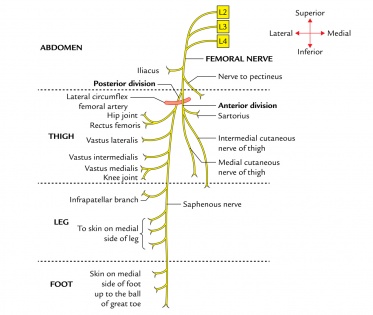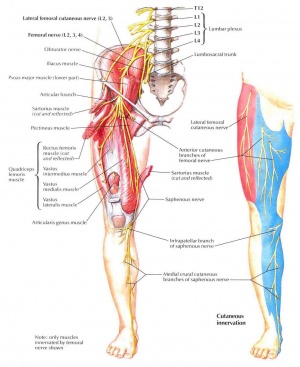Femoral Nerve
Original Editor - Mandeepa Kumawat
Top Contributors - Lucinda hampton, Mandeepa Kumawat, Kirenga Bamurange Liliane, Naomi O'Reilly, Vidya Acharya, Khloud Shreif, Joao Costa, Eric Henderson and Kim Jackson
Introduction[edit | edit source]
The femoral nerve is the largest nerve of the lumbar plexus. It originates from the dorsal divisions of the L2-L4 ventral rami. It has a role in motor and sensory processing in the lower limbs. It controls:
- The major hip flexor muscles, as well as knee extension muscles.
- Sensation over the anterior and medial thigh, as well as medial leg down to the hallux. [1]
Anatomy[edit | edit source]
In the Pelvis
- The nerve emerges from behind the psoas muscle to run laterally, deep to the iliac fascia above the iliacus muscle.
- Muscular branches are first given off to the psoas and then to the iliacus muscles (sometimes known together as the iliopsoas muscle) before the nerve runs beneath the inguinal ligament.
It then enters the thigh
- It begins lateral to the femoral artery (behind the inguinal ligament), dividing approximately 4 cm below the inguinal ligament into anterior and posterior divisions.
- The anterior division gives rise to the medial and intermediate cutaneous nerves of the thigh and muscular branches to the sartorius and pectineus muscles.
- The posterior division supplies the quadriceps femoris muscles and then continues along the medial border of the calf as the saphenous nerve ( Figure 23–2 ).
The lateral thigh is not supplied by the femoral nerve but is innervated by the lateral femoral cutaneous nerve , which is derived directly from the lumbar plexus, receiving innervation from the L2–L3 nerve roots.
Branches[edit | edit source]
Motor[edit | edit source]
The first motor branch innervates iliacus[3]. This muscle, in conjunction with the psoas major, causes medial rotation of the hip. The anterior branch of the femoral nerve then descends to supply the sartorius (the tailor’s muscle). Once it passes through the femoral canal (as the most lateral structure of the neurovascular bundle), it supplies the pectineus, a small muscle in the medial compartment of the thigh. Finally, the posterior branch of femoral nerve supplies the four heads of the quadriceps femoris (vastus medialis, vastus lateralis, vastus intermedius and rectus femoris)[4]. The articularis genu is supplied by a branch of the nerve to vastus intermedius.[5]
Sensory[edit | edit source]
The anterior (superficial) branch of the femoral nerve first gives rise to the intermediate and medial cutaneous nerve of the thigh[6].They supply the skin on the anteromedial thigh. The posterior division gives only one cutaneous branch, the saphenous nerve which supplies the skin on the medial side of the foot and leg. The femoral nerve also innervates the capsule of the hip joint and allows for proprioceptive feedback about the joint.[3]
Articular[edit | edit source]
- The hip joint is supplied by the nerve to the rectus femoris; and
- The knee joint is supplied by the nerves to the three vasti. The nerve to the vastus medialis contains numerous proprioceptive fibres from the knee joint, accounting for the thickness of the nerve. This is in accordance with Hilton’s law: Nerve supply to a muscle which lies across a joint, not only supplies the muscle, but also supplies the joint beneath and the skin overlying the muscle.[5]
Vascular[edit | edit source]
To the femoral artery and its branches.
Clinical relevance[edit | edit source]
Injury[edit | edit source]
Injury of the femoral is uncommon but may be injured by a stab, gunshot wounds, or a pelvic fracture. The femoral nerve can be damaged during penetrating trauma to the thigh. It can also be damaged during hip operations, particularly the anterior approach (not commonly used) where the nerve can be stretched and damaged. Listed here are the characteristic clinical features:
Motor loss[edit | edit source]
- Poor flexion of the hip, because of paralysis of the iliacus and sartorius muscles.
- Inability to extend the knee, because of paralysis of the quadriceps femoris.
Sensory impairment[edit | edit source]
- Sensory decline over the anterior and medial aspects of the thigh, as a result of engagement of the intermediate and lateral cutaneous nerves of the thigh.
- Sensory loss on the medial side of the leg and foot up to the ball of the great toe (first metatarsophalangeal joint), because of engagement of the saphenous nerve.[7]
Patellar tendon reflex[edit | edit source]
The femoral nerve is responsible for the patellar tendon reflex (tests L3-L4 spinal component)
Femoral nerve neuropathy[edit | edit source]
It occurs when the femoral nerve is compressed as it passes under the inguinal ligament, anterior to iliopsoas.
Causes[edit | edit source]
- Direct trauma, the most common[8] ; results from surgery such as hysterectomy, pelvic, hip, femoral artery catheterization, arterial bypass [4]
- Compression due to retroperitoneal tumors as in diabetes mellitus [4] or subsequent to spontaneous hemorrhage within the iliopsoas muscle has become a serious and more frequent clinical problem.[9]
- Iatrogenic from (ie. percutaneous proximal interlocking screw placement through IM nail)[8] or increased use of anticoagulants [9]
Femoral nerve block[edit | edit source]
Femoral nerve block (in combination with sciatic nerve block) may be indicated in patients requiring lower limb surgery who cannot tolerate a general anaesthetic. A femoral nerve block can also be used as peri- and post-operative analgesia for patients with a fractured neck of femur who cannot tolerate particular analgesics.
See also[edit | edit source]
References[edit | edit source]
- ↑ Refai NA, Tadi P. Anatomy, Bony Pelvis and Lower Limb, Thigh Femoral Nerve. StatPearls [Internet]. 2020 Oct 27.Available: https://www.ncbi.nlm.nih.gov/books/NBK556065/(accesseed 17.1.2022)
- ↑ 2.0 2.1 Femoral Nerve Anatomy - Everything You Need To Know - Dr. Nabil Ebraheim. Available from: https://www.youtube.com/watch?v=zdgJueAZaxU [last accessed 24/06/2018]
- ↑ 3.0 3.1 Femoral Nerve. Available from:https://www.kenhub.com/en/library/anatomy/femoral-nerve (Accessed, 24/06/2018).
- ↑ 4.0 4.1 4.2 Femoral Nerve. Available from: https://www.earthslab.com/anatomy/femoral-nerve/ (Accessed, 22/06/2018).
- ↑ 5.0 5.1 Chaurasia, B., 2013. Human Anatomy Volume 2 Regional and Applied Dissection and Clinical Lower Limb , Abdomen and Pelvis.. 6th ed. India CBS Publisher and Distributors Pvt Ltd.
- ↑ The Femoral Nerve. Available from: https://teachmeanatomy.info/lower-limb/nerves/femoral-nerve/ (Accessed, 24/06/2018).
- ↑ Ellis, H., 2006. Clinical Anatomy A revision and applied anatomy for clinical students. 11th ed. Blackwell Publishing Ltd.
- ↑ 8.0 8.1 Femoral Nerve. Available from: https://www.orthobullets.com/anatomy/10111/femoral-nerve (Accessed, 19/07/2021).
- ↑ 9.0 9.1 Casoni P, Dalla Valle R. Femoral neuropathy due to a spontaneous hematoma of the iliopsoas muscle during therapy with heparin-calcium. Acta bio-medica de L'Ateneo parmense: organo della Societa di medicina e scienze naturali di Parma. 1994 Jan 1;65(5-6):289-96.








